Ausbil: 3 stocks to play Europe's global arms race in power, defence and AI
For years, the US market has led global equity growth, but soaring valuations now suggest much of the upside is already included in prices.
Meanwhile, Europe, having been in the growth doldrums, is stepping into the spotlight with fresh government spending and attractive valuations, fuelling new opportunities.
Ausbil’s Global Small Cap Team argues that shifting focus to select European companies could unlock unrecognised earnings growth.
Please note this is an abridged version of the Ausbil whitepaper 'Europe: The centre of Europe's global arms race, in power, defence and AI'. A link to the full version can be found at the bottom of this page.
A shift in direction: Europe reawakening
Ausbil’s view of the US economy is that tariffs will have a downward drag on growth in the near term before growth begins to build again at the end of 2025, and into 2026.
Over the last few quarters, however, valuations in the US have risen to elevated levels relative to both the rest of the world and their own historical averages.
While we continue to anticipate robust earnings growth in the US, we now see significantly more potential for unrecognised earnings growth emerging from the European region.
Shifting from the US to Europe
Toward the end of last year and earlier this year, we began trimming positions and taking profits in US companies that had performed well over recent years. The capital freed up was redeployed into several European companies with strong projected earnings growth. Europe appears compel- ling when compared to the US for several reasons.
First, valuations in the European Union and the UK remain comparatively attractive, especially as US valuations have continued to climb.
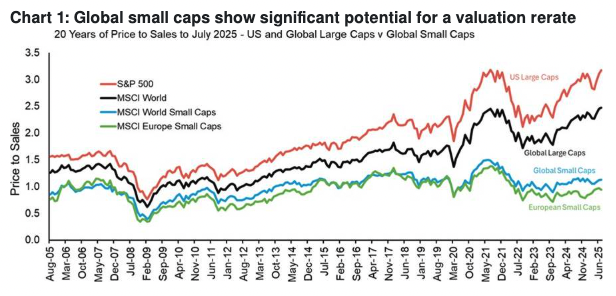
Second, European governments are now making clear and quantifiable commitments to increase fiscal spending, a significant shift after many years of conservative fiscal policy. This includes significant increases in defence spending, and in related areas like energy, information technology and industrials.
Defence spending and investment by the European Union has been accelerating over many years and is at record levels. Defence spending by EU states increased by more than 30% since 2021, and is expected to increase by at least 30% gain by 2027, or over EUR100 billion.
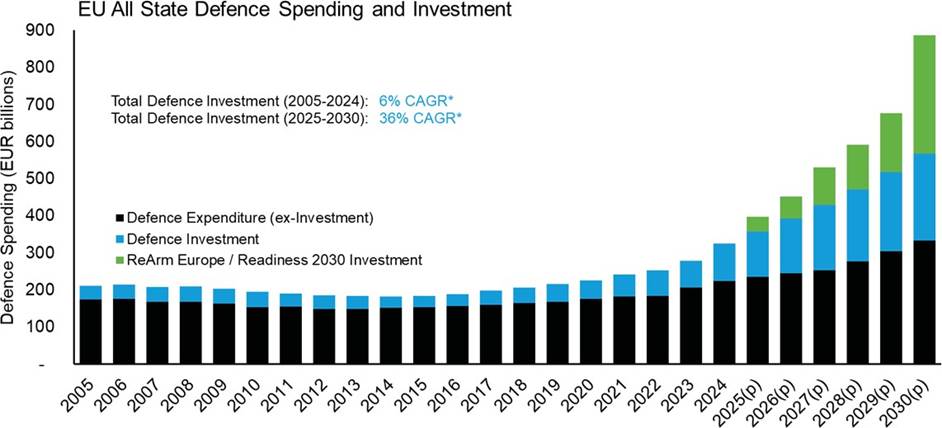
In terms of growth, for the 20 years from 2005 to 2024, defence spending rose at a compound annual growth rate (CAGR) of 2.3%. Though defence spending was contracting between the GFC in 2008/9 and around 2014, it began accelerating again as Russia increasingly became isolated from other developed nations.
Since the invasion of Ukraine by Russia in 2022, defence spending by the EU has shown a CAGR of 9.9% based on the projected growth in defence spending to 2027.
Opportunities in an emergent Europe
Given the macro backdrop, the outlook for stronger growth in Europe, and more fiscal and defence spending, sees Europe at the centre of a global arms race in power, defence and AI.
Increases in fiscal and defence spending will have a multiplier effect, delivering positive impacts on the wider European economy and on some European companies in particular. Industrial sectors such as engineering, aerospace, shipbuilding, electronics, logistics and IT stand to benefit significantly.
Furthermore, much of the fiscal spending is mandated to remain within European borders wherever possible, which should boost local industries such as steel production, truck manufacturing, and logistical engineering.
Three companies that we think are positioned to benefit as Europe builds out its defences, its electrical grid and energy independence, and its AI and data centre capacity include R&S Group (Switzerland), AQ Group (Sweden) and Warehouses De Pauw (Belgium).
Logistics and warehousing in environment of rising growth
Warehouses De Pauw (EDR: WDP) is a real estate investment trust, which engages in the development and leasing of logistic and semi-industrial real estate properties across Europe (Belgium, The Netherlands, France, Germany, and Romania).
Real estate investment trusts had a punishing 2022-2024 with restrictive monetary policy and slow growth, however, with the European Central Bank in an easing cycle and the economy rebounding, leaders in logistics like WDP are set to capture upside in business activity and investment.
Moreover, lower rates correspond with tighter cap rates which is an additional tailwind for valuations for companies like WDP.
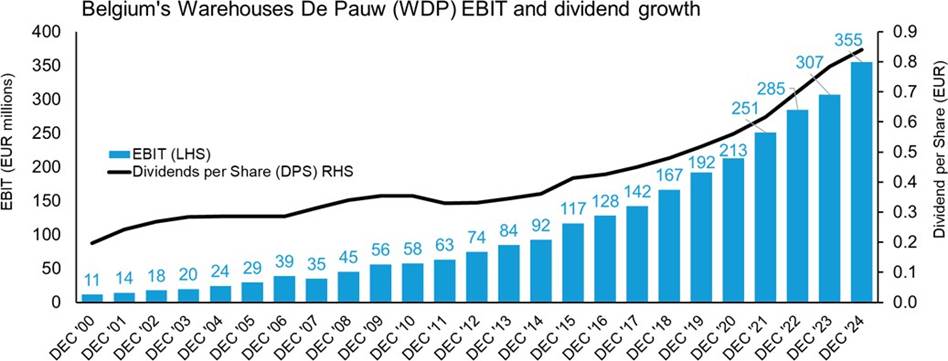
However, with a strong earnings growth outlook in an economy that will spend more, WDP is underappreciated by the market and ripe to generate growth as Europe’s GDP expands into 2026.
Power and AI driving secular investment
The EU is witnessing major investment in the electrical transmission network across Europe, with capex investment in the coming five years (2025-2029) at multiples of the level undertaken in the last five years (2020-2024), ranging from 2x to 7x the amount invested previously.
This capex spend by EU transmission system operators (TSOs) will benefit companies across the value chain in electrical engineering, services, transformers, transmission and technology.
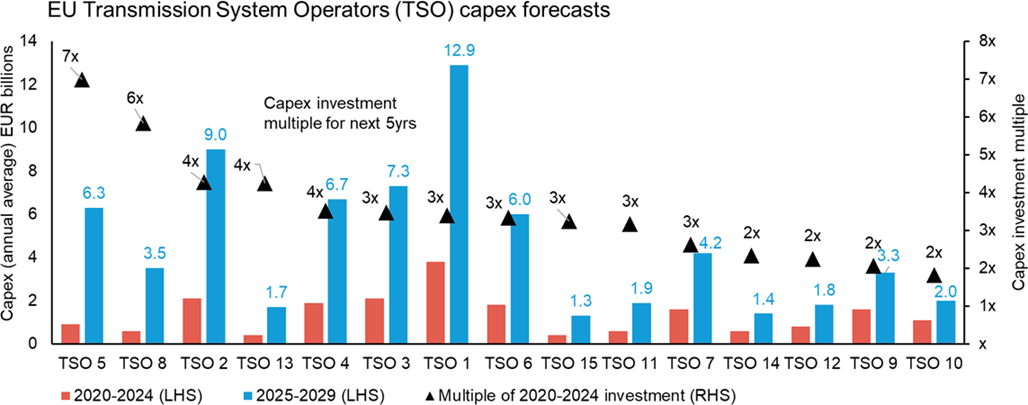
Source: Ausbil, S&P Capital IQ, TSO company filings as at end 2024.
Globally, grid expansion for the electrification of things is a major secular growth opportunity. Capex and resources investment on the world’s electrical distribution and transmission infrastructure will cost between US$750 bn to over US$1 trillion annually, depending on the energy scenarios that play out, in order for the world to meet Net Zero targets.
Underpinning the demand for efficiency and electrification is the demand that AI and cloud computing has added to energy demand and transmission capacity.
Two companies that we have found that potentially benefit from this boom in capex spend are R&S Group and AQ Group.
R&S Group (SWX: RSGN), based in Switzerland, provides electrical infrastructure product, and engages in the business of power distribution transformers, and the supply of components like cast resin and power transformers and medium and high voltage switching devices.
R&S also offer specific railway electrification products and industrial electrical connectors, an area that we are seeing as a major beneficiary of increased global trade and activity not just in Europe but also in the US. We see R&S as a major beneficiary of the rebuild in Europe, in fiscal and defence spending.
We believe AQ Group (STO: AQ) in Sweden is another beneficiary of the re-emergence of European growth. AQ Group engages in the manufacture of components and systems for industrial customers.
Their component segment offers transformers, cabling, mechanical solutions, sheet metal processing, and injection moulded thermoplastics. The system segment produces systems, automation, and power solutions, as well as complete machines in close cooperation with customers.
AQ Group is another case where we have identified unrecognised growth in a company that has a history of delivering strong earnings growth (16% CAGR since 2000).
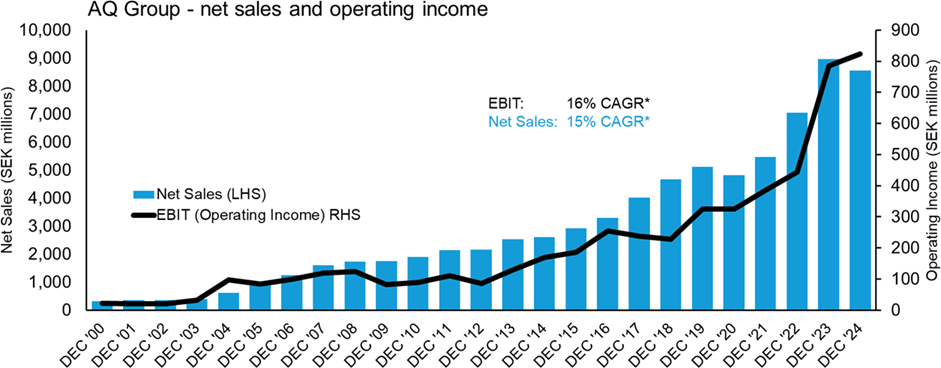
Source: Ausbil, Bloomberg, to end June 2025. *CAGR for full years from 2000 to 2024 (does not include 6 months to June 2025).
In summary
While markets are inherently uncertain, our research and analysis point to strong opportunities for high-quality European businesses that are niche leaders in their respective industries (such as WDP, R&S and AQ Group cases in point).
The combination of attractive valuations, robust government spending commitments, and a heightened focus on defence and security provides compelling reasons that support our ethos of being overweight in European equities.
Currently, we believe market valuations do not reflect these new opportunities, and companies like those we have covered may benefit from valuation rerates with the European Union collectively working to deliver strong future growth for the first time in over a decade.
This is an abridged version of 'Europe: The centre of Europe's global arms race, in power, defence and AI'. Access the full whitepaper here.

4 topics
1 fund mentioned

